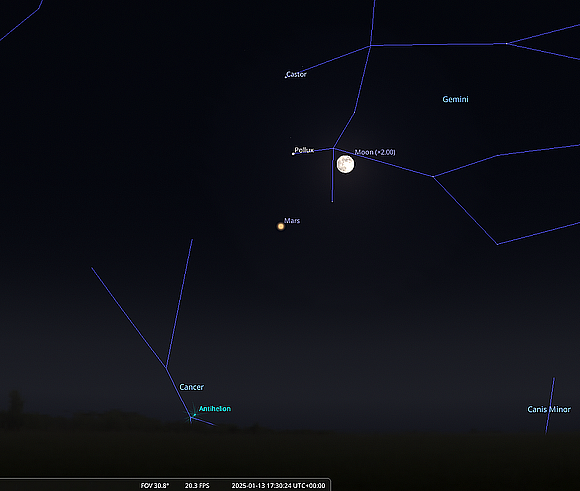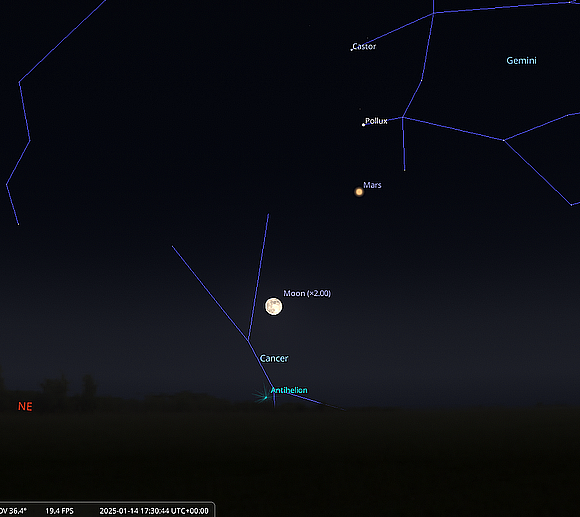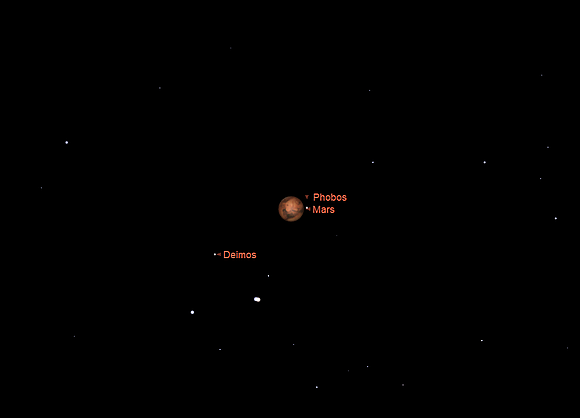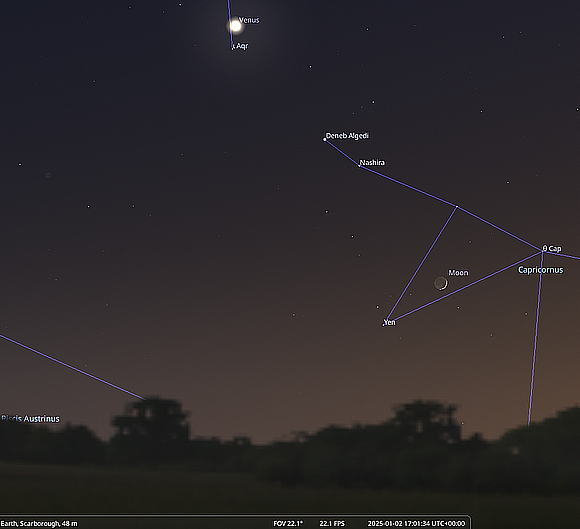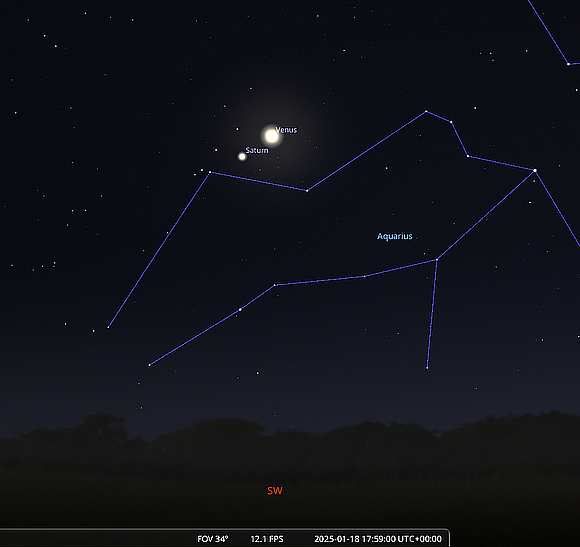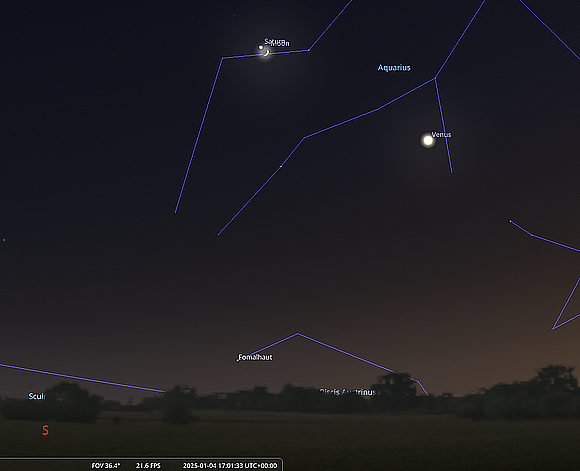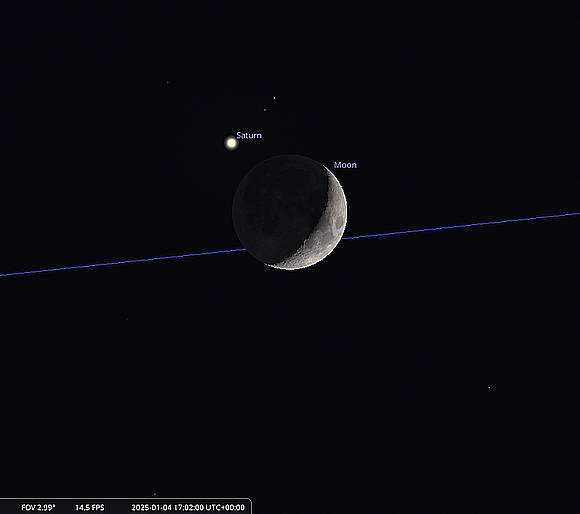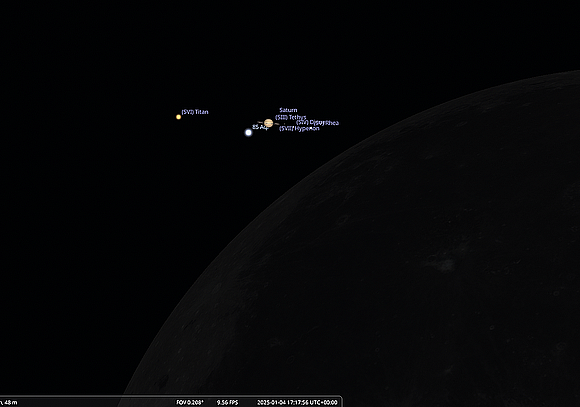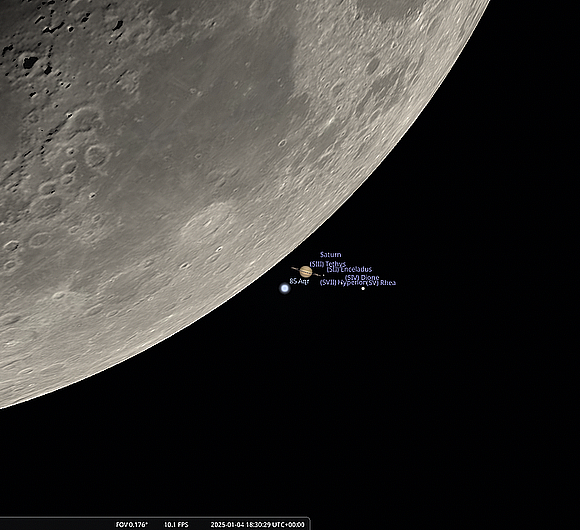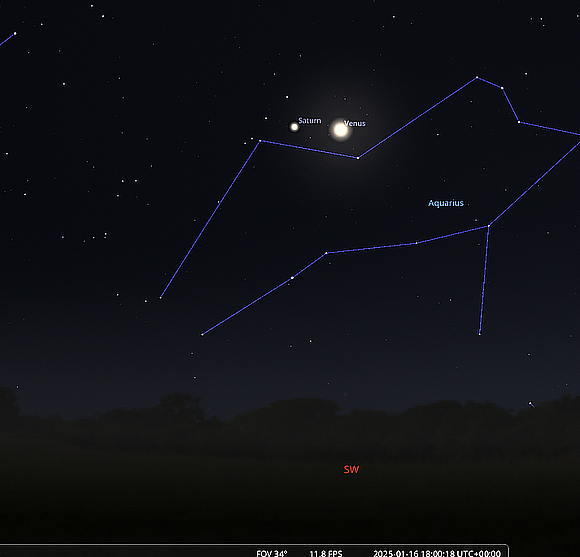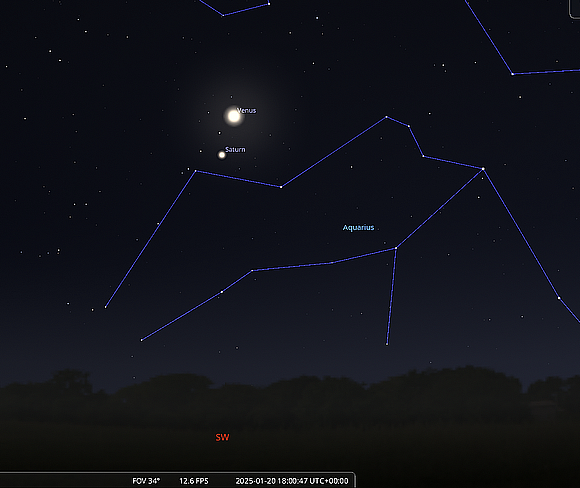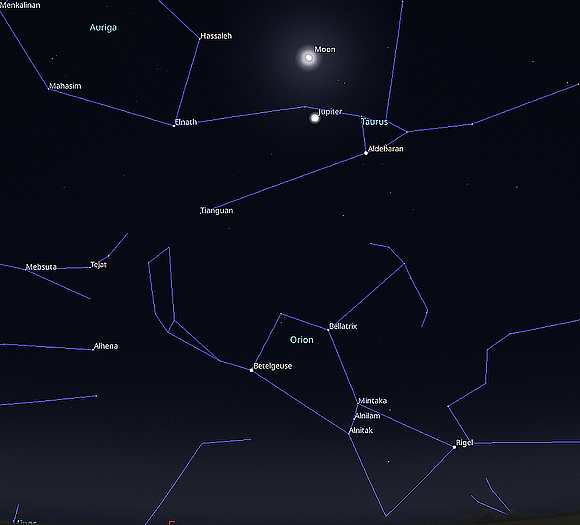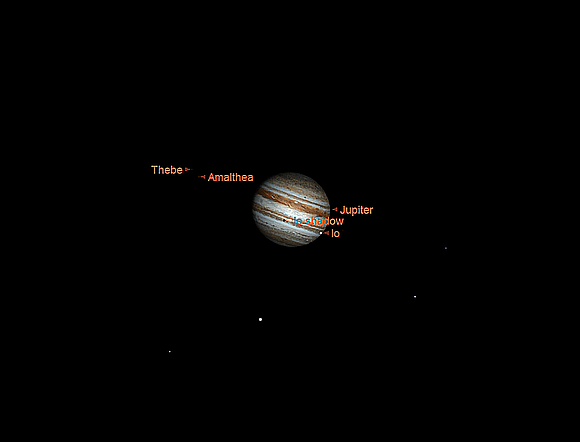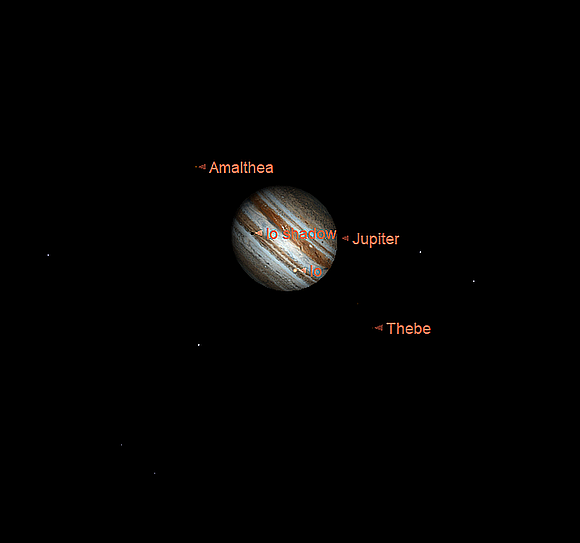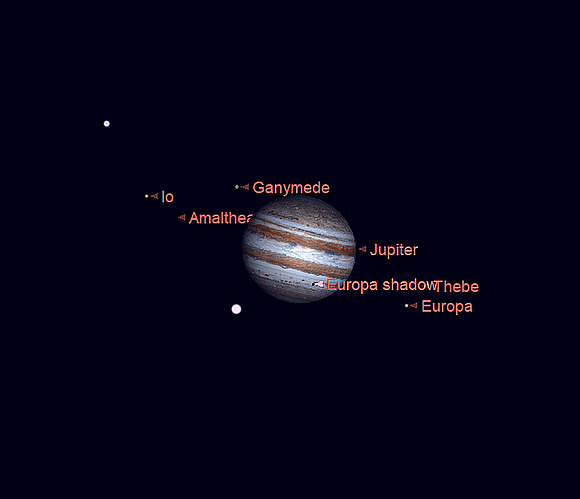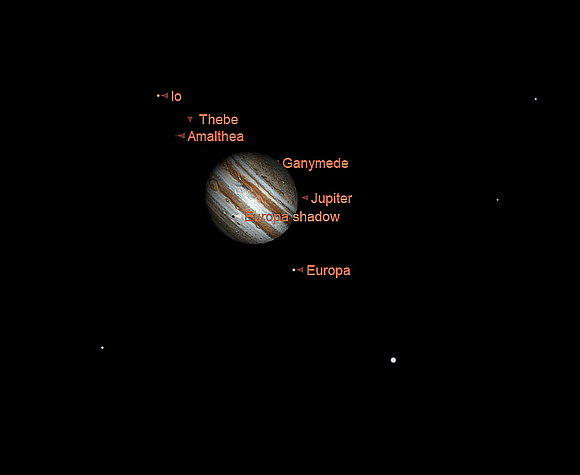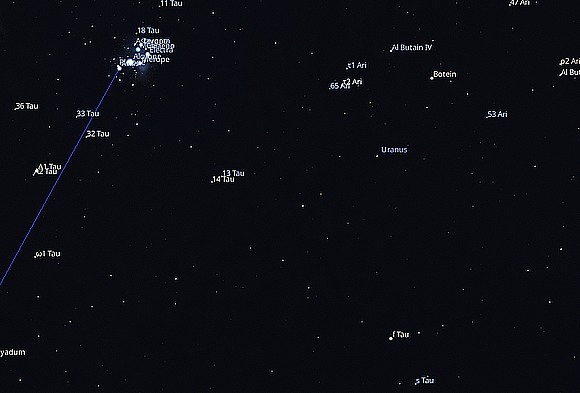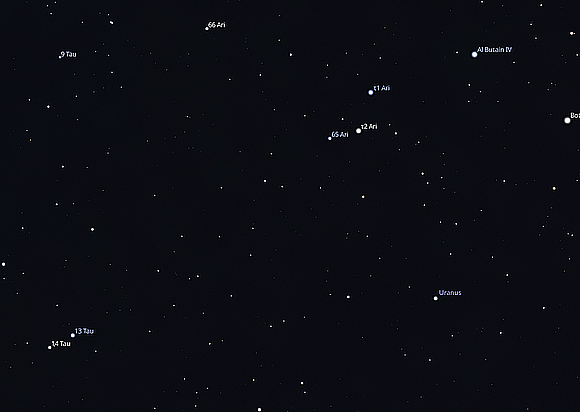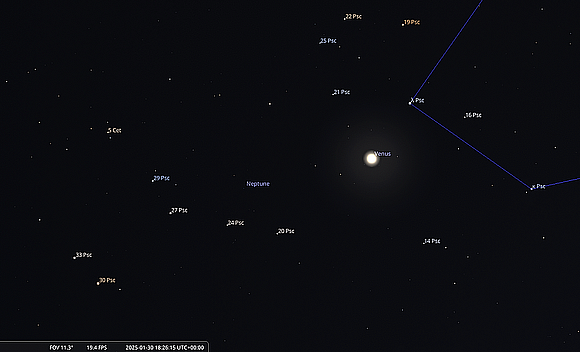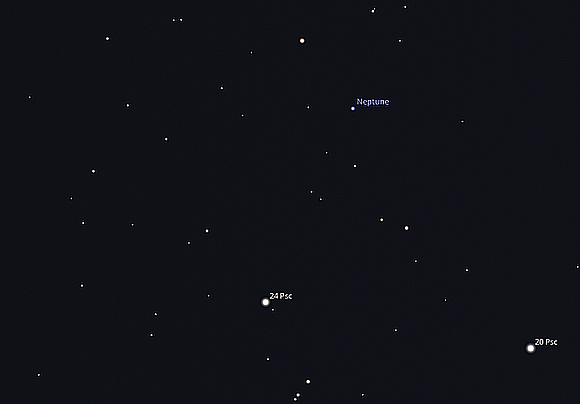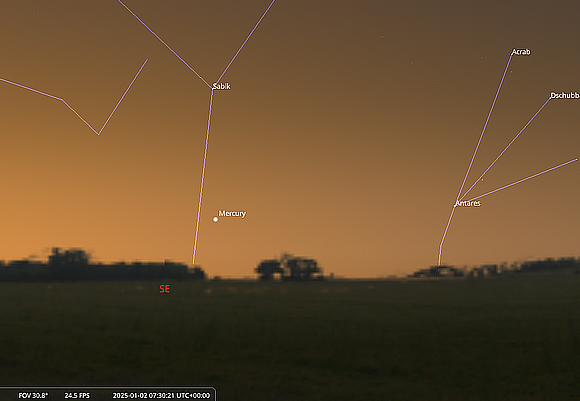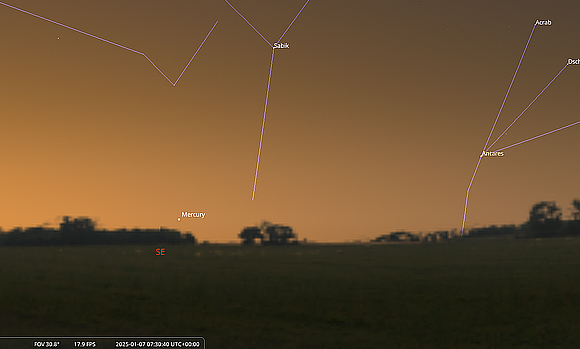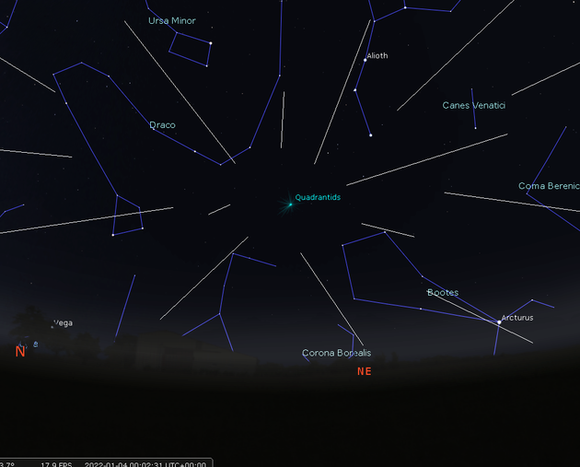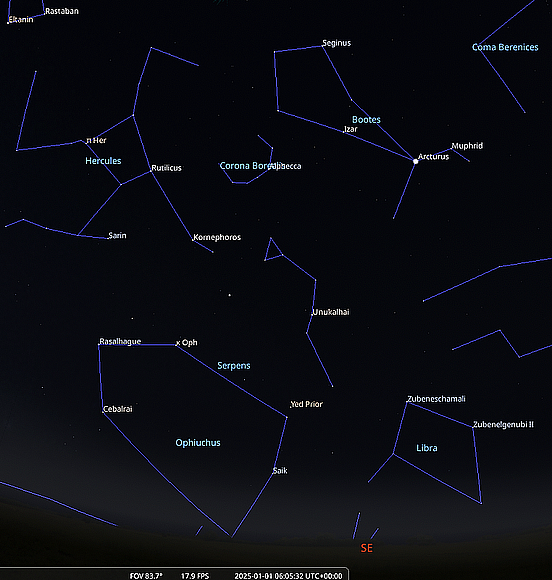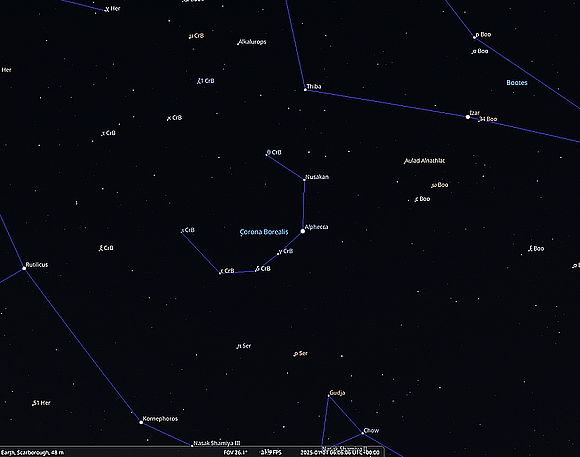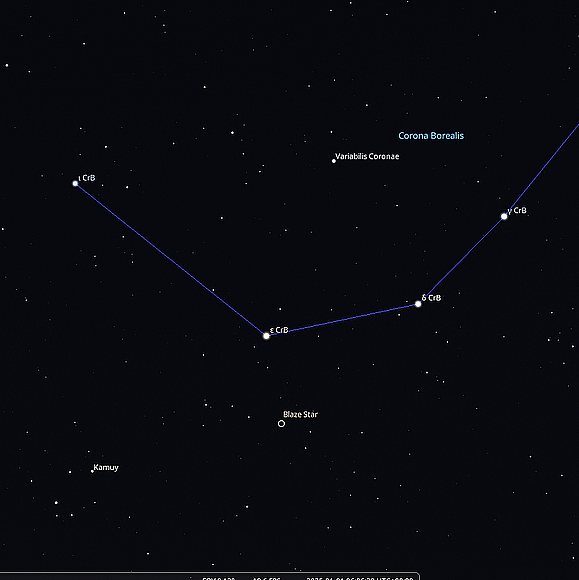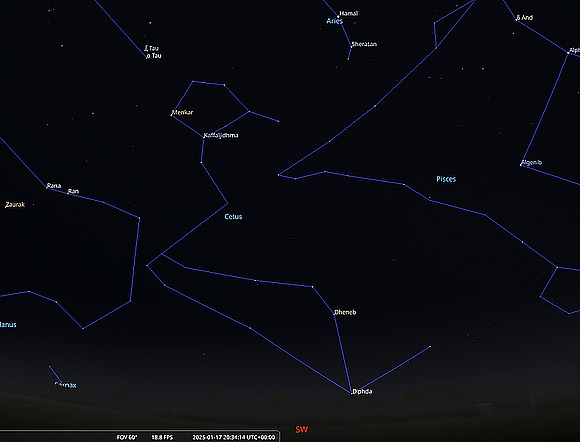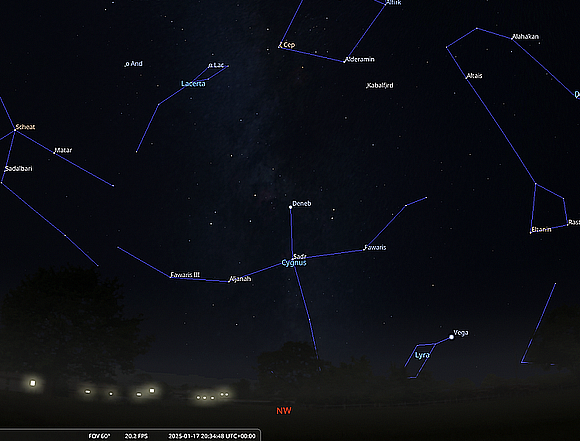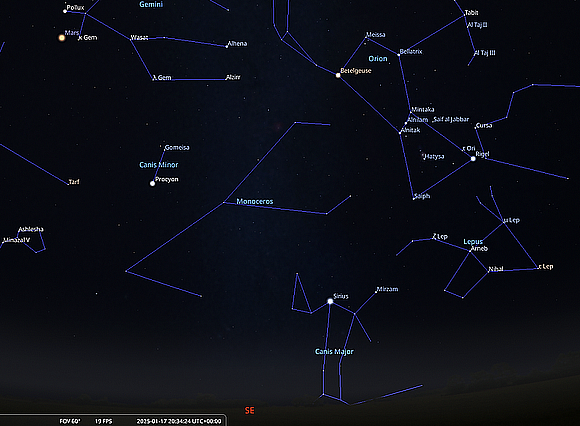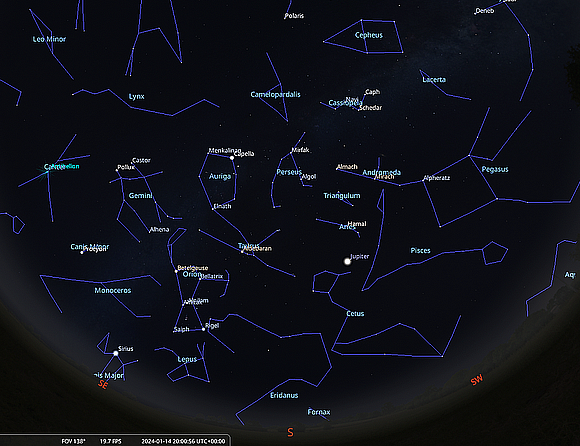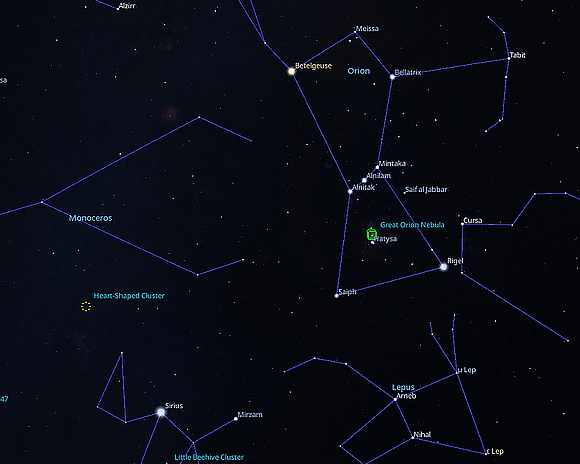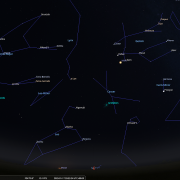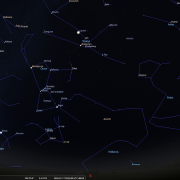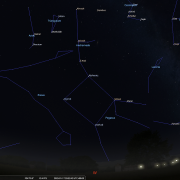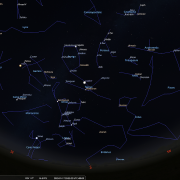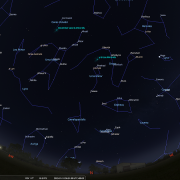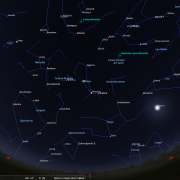In this month's Sky Notes:
- Planetary Skylights.
- January Meteors & Comet C/2024 G3 (ATLAS).
- Nova T Cor Borealis - alert
- January Night Sky.
- January 2025 Sky Charts.
Planetary Skylights - Brief
It’s a busy start to the New Year as Mars comes to opposition - growing ever more prominent. Venus dominates the early evening sky, Jupiter the rest of the night. Saturn is sinking into the SW aspect but is occulted by the Moon and later in the month meets Venus. Uranus and Neptune both require telescopic aid to show as a disk. Mercury concludes a reasonable morning apparition.
 Mars grows ever more prominent as we head into the New Year arriving at opposition on January 16th and therefore visible all hours of darkness. The red planet will be apparent by 17:15hrs GMT above the ENE horizon as the new year commences, at magnitude -1.2 the third brightest planet visible in the twilight sky after Venus and Jupiter. By opposition date the red planet will have brightened further to mag -1.4. Opposition occurs in the early morning hours of Jan 16th, although nearest approach by Mars to Earth occurs on Jan 12th when it lies 96 million km (60 million miles) away - so it is not the closest of oppositions.
Mars grows ever more prominent as we head into the New Year arriving at opposition on January 16th and therefore visible all hours of darkness. The red planet will be apparent by 17:15hrs GMT above the ENE horizon as the new year commences, at magnitude -1.2 the third brightest planet visible in the twilight sky after Venus and Jupiter. By opposition date the red planet will have brightened further to mag -1.4. Opposition occurs in the early morning hours of Jan 16th, although nearest approach by Mars to Earth occurs on Jan 12th when it lies 96 million km (60 million miles) away - so it is not the closest of oppositions.
For UK observers it will be reasonably favourable, Mars residing much higher in the sky within the constellation of Gemini and in line with Castor and Pollux as it continues in retrograde motion - moving westwards against the background stars. Mars will spend over 8 hours above the 25-degree elevation mark below which poor 'seeing' can compromise the image through the eyepiece and will culminate over 60-degrees to the south! There is plenty of observing hours then to scrutinise the Martian disk some 14.5 arc-seconds in diameter (it can attain 25 arc-seconds at close oppositions) but it should appear quite sharp.
Through the eyepiece the Martian disk will appear that familiar rusty orange hue, but with good seeing in apertures over 100mm (4") darker surface markings will be visible in medium/high powers. Don't push the power too much so that it becomes dimmer and less sharp. Around opposition - mid-month, look for the 'V wedge' or 'fin shape feature' of Syrtis Major, below which resides a pale oval - the Hellas basin. You may also spot the small northern polar cap.
Quite often when at opposition (especially closer ones) major dust storms can arise on Mars blotting out regions of the surface completely, occasionally the whole disk, these may last days, or even weeks. Hopefully, dust storms should be minimal at this opposition, but if the Martian disk looks a featureless orange ball, you will know conditions on the surface are not good! The Moon lies in the vicinity of Mars on Jan 13 and 14th. From parts of the US, Mars is occulted by the Moon on Jan 14th, but not from this side of the pond!
Mars on opposition night - typical image in 150mm (6") scope -medium/high power.
(Click for larger image)
 Venus continues to gain in elevation as we plunge headlong into the new year, ever more noticeable as evening twilight descends increasing in brightness to a dazzling magnitude -4.5 and reaching 24-degrees in elevation above the SW horizon. Venus continues to approach Earth in its orbit, its disk size increasing from 22 arc-seconds to almost 32 arc-seconds by the month's end, the phase illumination diminishing from 55% to 38% at the same time. Venus will have closed to within 78 million km (48 million miles) by then. Venus can appear dazzling through the eyepiece, so, if possible, try to observe in twilight to discern the phase more easily.
Venus continues to gain in elevation as we plunge headlong into the new year, ever more noticeable as evening twilight descends increasing in brightness to a dazzling magnitude -4.5 and reaching 24-degrees in elevation above the SW horizon. Venus continues to approach Earth in its orbit, its disk size increasing from 22 arc-seconds to almost 32 arc-seconds by the month's end, the phase illumination diminishing from 55% to 38% at the same time. Venus will have closed to within 78 million km (48 million miles) by then. Venus can appear dazzling through the eyepiece, so, if possible, try to observe in twilight to discern the phase more easily.
At the start of January a new crescent Moon passes Venus on the 2nd and 3rd evenings. The view on the 3rd particularly pleasing with the Moon and Venus quite close. View around 17:00hrs.
As Venus continues to climb into the twilight sky, note how it draws closer to Saturn descending to the SW horizon. The two meet in conjunction from Jan 16th to Jan 20th, closest conjunction being on the 18th when the pair are separated by just over two degrees. To the naked eye Venus will swiftly pass Saturn in just a few days.
 Saturn remains visible throughout January but is setting by 19:30hrs by the end of the month from UK latitudes. It will remain a viable early evening observing target until the third week in January, but more importantly is involved in two spectacular conjunctions: being occulted by the Moon on the 4th and buzzed by Venus shortly after mid-month.
Saturn remains visible throughout January but is setting by 19:30hrs by the end of the month from UK latitudes. It will remain a viable early evening observing target until the third week in January, but more importantly is involved in two spectacular conjunctions: being occulted by the Moon on the 4th and buzzed by Venus shortly after mid-month.
You can locate Saturn low in the SW as twilights falls, a magnitude +0.9 object, conspicuous amongst the faint stars of Aquarius. Through the eyepiece Saturn is normally a visual delight, however the orientation of the ring system is currently less than 4 degrees and diminishing as the next ring plane crossing event approaches in March 2025. It is a pity that for UK observers this event will poorly observed with Saturn lost in twilight glare by March.
What Saturn lacks for in visual appeal this month, it more than makes up for in planetary action. First up is an occultation of the planet by the crescent Moon on January 4th. Observers will note Saturn's proximity to the Moon as twilight falls and by 17:00hrs it will appear to be almost touching the dark, unlit lunar limb. Actual ingress will commence around 17:22hrs GMT from the latitude of Whitby. This should be easily followed, looking spectacular in telescopes at medium powers as the dark limb of the Moon moves to hide Saturn.
The view through a telescope - low-moderate power shortly before ingress 17:17hrs.
(Click for full image)
The occultation lasts for just over an hour with Saturn exiting the lit lunar crescent limb around 18:30hrs GMT from our latitude. This may be more difficult to distinguish with lunar glare making exact timings more challenging - certainly with the naked eye.
Through the eyepiece and given any decent 'seeing', Saturn will appear somewhat unfamiliar to anyone who views the planet only occasionally, the rings orientated as they are. Saturn's largest moon, Titan, will however be visible as a speck of light nearby in nearly all instruments. As Saturn draws closer to the SW horizon the image will degrade further, so make the most of observing opportunities during the first half of January. Shortly after mid-month your eye will be drawn toward the second conjunction involving Saturn, this time with Venus moving smartly in the opposite direction - away from the horizon. See Venus for further details.
 After the departure of Venus earlier in the evening, Jupiter, at magnitude -2.8 is then the dominant planet for the rest of the night, with a good observing window exceeding 10 hours. Located in Taurus the Bull, Jupiter continues to move in retrograde motion - westwards, tracking back toward Aldebaran, chief star in Taurus culminating an impressive 60-degrees in altitude above the south horizon.
After the departure of Venus earlier in the evening, Jupiter, at magnitude -2.8 is then the dominant planet for the rest of the night, with a good observing window exceeding 10 hours. Located in Taurus the Bull, Jupiter continues to move in retrograde motion - westwards, tracking back toward Aldebaran, chief star in Taurus culminating an impressive 60-degrees in altitude above the south horizon.
Through the eyepiece Jupiter exhibits an oblate disk some 45 arc seconds in diameter flanked by the Galilean moons - visible as specks of light. The dark equatorial belts will be readily visible in instruments as small as 60mm (2.5”) aperture, with the less evident polar regions apparent in 75mm (3") instruments. Larger instruments will show the finer northern and southern temperate belts.
When orientated in our direction look for the great red spot feature, a colossal storm system, which over the last four decades appears to have diminished both in size and hue intensity. The GRS can be observed in 100mm (4”) scopes but will be more obvious with 150mm (6”) instruments at medium powers. Look for the GRS on Jan 1st, 4th, 6th, 13th, 16th, 18th, 23rd, 25th and 30th between 19:00hrs and 21:00hrs.
Observe Jupiter regularly and you will note the 'dance' of the Galilean moons; Io, Europa, Ganymede and Callisto around Jupiter, throwing up a different configuration each night. Look for shadow transits of these moons (visible as black dots transiting the disk of Jupiter) which are particularly fascinating to follow. Apertures of 100mm (4") plus with medium/high magnification should suffice. The moons themselves are more difficult to spot as they pass in front of Jupiter, requiring much larger apertures. The most favourable evening shadow transits in January are; Io - Jan 16th @ 18:30hrs and Jan 23rd @ 20:00hrs. Europa - Jan 17th @ 18:30hrs and Jan 24th @ 20:00hrs.
 Uranus is ideally placed for observation in the mid-evening sky located approximately 5 degrees lower right of the Pleiades star cluster in Taurus the Bull. At mag +5.6 Uranus is technically visible to the naked eye from a dark location with use of a star chart or sky app to aid. Binoculars will show it as a speck, but apertures of 80mm plus (3"+) are required to spot the tiny 3.7-degree grey-green disk. Instruments of 150mm (6") and above will resolve this more clearly. The nearby pairing of 13 and 14 Tau (both 5th magnitude stars) lay one degree to the left. Uranus is a viable observing object until the early morning hours.
Uranus is ideally placed for observation in the mid-evening sky located approximately 5 degrees lower right of the Pleiades star cluster in Taurus the Bull. At mag +5.6 Uranus is technically visible to the naked eye from a dark location with use of a star chart or sky app to aid. Binoculars will show it as a speck, but apertures of 80mm plus (3"+) are required to spot the tiny 3.7-degree grey-green disk. Instruments of 150mm (6") and above will resolve this more clearly. The nearby pairing of 13 and 14 Tau (both 5th magnitude stars) lay one degree to the left. Uranus is a viable observing object until the early morning hours.
 Neptune remains available for telescopic observation throughout January evenings approximately 13 degrees upper left of Saturn. It may be tracked down below the faint loop of stars marking the western fish of Pisces - in particular lambda Piscium (mag 4.5). The nearest 'bright' stars are the chain of 5th magnitude stars 20, 24, 27 & 29 Piscium a degree to the right of Neptune. Neptune itself is at 7th magnitude appearing as a tiny 2.4 arc-second disc through the eyepiece. You will require at least a 100mm (4") aperture at 100x magnification and good seeing to glimpse this, but a 150mm (6”) scope at medium/high magnification to clearly define it. Venus resides between Neptune and the 'loop' of Pisces during the dying days of the month, by which time Neptune sets by 20:30hrs GMT from the UK.
Neptune remains available for telescopic observation throughout January evenings approximately 13 degrees upper left of Saturn. It may be tracked down below the faint loop of stars marking the western fish of Pisces - in particular lambda Piscium (mag 4.5). The nearest 'bright' stars are the chain of 5th magnitude stars 20, 24, 27 & 29 Piscium a degree to the right of Neptune. Neptune itself is at 7th magnitude appearing as a tiny 2.4 arc-second disc through the eyepiece. You will require at least a 100mm (4") aperture at 100x magnification and good seeing to glimpse this, but a 150mm (6”) scope at medium/high magnification to clearly define it. Venus resides between Neptune and the 'loop' of Pisces during the dying days of the month, by which time Neptune sets by 20:30hrs GMT from the UK.
 Mercury concludes a respectable morning apparition during the initial week of January. Look for this elusive planet low in the SE from 07:15hrs during the first week in January just a few degrees above the horizon, a good clear aspect is essential for this. At magnitude -0.35 Mercury should be readily apparent in binoculars before trying with just the naked eye. Antares - chief star in Scorpius resides off to the right of Mercury. Thereafter, Mercury will slip back toward the horizon and will be lost by the 10th. View 45 mins before sunrise.
Mercury concludes a respectable morning apparition during the initial week of January. Look for this elusive planet low in the SE from 07:15hrs during the first week in January just a few degrees above the horizon, a good clear aspect is essential for this. At magnitude -0.35 Mercury should be readily apparent in binoculars before trying with just the naked eye. Antares - chief star in Scorpius resides off to the right of Mercury. Thereafter, Mercury will slip back toward the horizon and will be lost by the 10th. View 45 mins before sunrise.
January Meteors
Meteor activity remains high as the New Year offers up one of the big three meteor showers - the Quadrantids, with a ZHR peak rate topping 100. The shower is named after the now defunct constellation of Quadrans Muralis, removed from sky charts in 1922, but used to lie at the junction between Hercules, Boötes and Ursa Major. The Quadrantids are the least observed of the major meteor showers, factors such as timing, weather, and a short peak duration of just a few hours at play here. The Quadrantids 'meteoroid' stream is constantly evolving, with the orbit appearing to oscillate up and down relative to the plane of the Ecliptic. During the early centuries AD, the shower stream was encountered in July as an Aquarids radiant! The shower was then missing for over a thousand years before reappearing in the 1700s again. The shower will again be 'lost' in another 300-400 years.
Minor Quadrantid activity ranges from late December until Jan 12th, but rapidly diminishes to sporadic levels after Jan 6th. During the evening of January 3rd, the shower radiant is positioned low to the North and few meteors will be seen. The short-lived peak occurs in the early morning hours of the 4th, by which time the radiant will be positioned over 40 degrees above the ENE horizon. The good news is there will be no moonlight at all.
Peak Zenith Hourly Rates can exceed 100 under ideal conditions and circumstances, but don't expect to see anything like that number. Should skies be clear in the early morning hours an observer should expect to witness a respectable 30-40 meteors per hour this year. Quadrantids can be bright, sometimes blue, or green in hue. You will not require any additional optical assistance; the naked eye is quite sufficient. Check the forecast and if you fancy the chances set an alarm for 02:00hrs (I know...not a friendly hour), wrap up warm and enjoy.
Comet C/2024 G3 (ATLAS)
This comet could be the brightest of 2025... probably won't be and will break up, but you just never know with a comet, especially this type. Discovered on April 5th, 2024 by the automated (ATLAS) system, this is a sungrazer comet, a type which often fragment as they make a close solar passage. The comet has an orbital period of over 160,000 years, so has survived previous visits - astronomers believe, but for this one Comet C/2024 G3 will come within just 13.5 million kilometres (8.5 million miles) of the Sun, more than three times closer than Mercury's perihelion distance.
Should it survive its perihelion passage around the Sun on January 13th (and as of writing near the end of 2024 it remains intact), the comet may attain a magnitude of -4.4, as bright as Venus and visible in twilight skies with the naked eye. It will be better placed for southern hemisphere observers, however there is a short window in which observers in the northern hemisphere may, (I emphasize May) also observe the comet in the evening twilight sky. A dog's chance, perhaps, but a chance, nevertheless.
The most likely dates the comet will be visible to UK observers are January 14th & 15th (perhaps up to the 18th), observing around 16:30hrs GMT just above the SW horizon - lower left of Venus. There will probably be less than 30 minutes of observational time - should the comet be bright enough to view, but it could be worth the chance - certainly trying to image the area would be a good bet, after all who doesn't appreciate the beauty and spectacle of a comet.
T Corona Borealis - Alert
T Coronae Borealis (T CrB), nicknamed the Blaze Star, is a binary star and a recurrent nova located in our sky in the constellation Corona Borealis. It was first discovered in outburst in 1866 by John Birmingham, having previously been observed as a 10th magnitude star. It then reached magnitude 2.1 and was visible to the naked eye about the same brightness as Polaris – the pole star. Then In February 1946 a 15-year-old schoolboy from Wales named Michael Woodman observed a flare up, subsequently writing to the Astronomer Royal and leading to the theory that the star flares each 80 years. On this occasion T CrB reached magnitude 2.5.
General location chart for Corona and Boötes in morning sky around 06:00hrs GMT.
(Click for full image)
The T CrB binary system is located 3,000 light-years away and is composed of a large cool red giant component star and a smaller, hot white dwarf star component, which is surrounded by an accretion disk all hidden inside a dense cloud of material from the red giant. For most of the time the red giant dominates the visible light output, and the system appears as an M3 giant. The two components are separated by 0.54AU (around 80 million km or 50 million miles) taking 228 days to orbit each other. During outbursts, the transfer of material from the red giant to the hot white-dwarf component increases greatly, material being dumped on the surface, which expands and eventually detonates hugely increasing its luminosity for several days before settling back to normality after a few weeks.
T CrB is closely monitored and within the last year or two tell-tale signs in brightness fluctuations have been observed leading astronomers to conclude a nova outburst is imminent, even overdue. The Blaze star is located just below the circlet of stars making up Corona Borealis. The constellation is quite distinctive, but not bright and resides to the left of the constellation Boötes highlighted by brilliant orange Arcturus. T CrB is normally only visible in large binoculars or a telescope.
Should the nova erupt in the next few days or weeks, the morning sky is where you will need to look – Corona being quite high to the NE by 06:00hrs. Corona will be visible by 02:00hrs in early January, but to make life easy 06:00-07:00hrs would be good for the first week. The nova could flare as late as March, by which time it will also be visible in the late evening sky. The nova will appear below, and 3 stars left of Gemma (also called Alphecca) the constellation's lead star – and may be of similar brightness. It will be visible to the naked eye for a few days only and with binoculars for a week or so before fading again.
Keep tabs of the media and the web, but ignore sensational reports of it being a brilliant object lighting up the sky - it is not a supernova, just a nova, but the nature of the outburst is still impressive, it’s not every day we get to observe a star suddenly brighten. For one Michael Woodman it will be his second time! Watch those skies and hope cloud is absent!
January Night Sky
As dusk falls southern and western aspects of the night sky are still dominated by seasonal autumnal constellations. The great square of Pegasus occupies much of the SSW, the orientation of the winged horse tilted down toward the horizon. Below Pegasus lie the less conspicuous constellations of Aquarius, Pisces and Cetus the whale (the Kraken in mythology), which continues to churn along the South horizon below Pisces. Use the front two stars in the square to locate the 'Krakens' brightest star - Diphda. Both Venus and Saturn currently reside in Aquarius, which departs the sky by the end of the month.
Winter it may be meteorologically and astronomically speaking, yet summer constellations still cling to the margins of the west-northwest aspect. Even the stars of the summer triangle all remain visible before 18:00hrs until the second week in January. Altair finally departing, leaving the circumpolar members of the summer asterism perilously close to the north horizon later in the evening. During early evening look for the crucifix form of Cygnus, the stars of which hang below its chief star Deneb above the WNW horizon. The sparkling steely-blue presence of Vega, the most conspicuous of the summer triangle stars resides lower in the NW.
Viewing North during the evening note the familiar ‘saucepan’ asterism of the Plough, part of Ursa Major, balancing on its handle above the NNE horizon. The rear 'bowl' stars of Plough; Dubhe and Merak, can be utilised to track down the pole star; Polaris due North. The 'North star' resides at the tail end of Ursa Minor - the Lesser Bear. The Celestial dragon, Draco winds its way between the two bears towards the NNW where the head of the beast is marked by an irregular quadrilateral of stars not far from Vega. Overhead, the zenith position is occupied in turn by the distinctive ‘W’ pattern of Queen Cassiopeia, followed later by Perseus (the outline of which resemble a distorted figure Pi symbol) and then the stars of Auriga the charioteer, highlighted by brilliant Capella, which lies just shy of the zenith at 22:00hrs. The faint stars of Lynx slink after the charioteer.
It is however to the South and East where the observer's gaze is treated to an array of imposing constellations rich in mythology and observational interest. Leading this wondrous stellar cavalcade is the constellation of Taurus the Bull, in which lie the two open star clusters of the Hyades and Pleiades. Prominent ruddy Aldebaran - 'the eye of the bull’ is the most conspicuous stellar presence in the Hyades, a ‘V’ or arrowhead arrangement of stars, although at 67 light years, Aldebaran is not a genuine member, a foreground object lying at half the distance of true Hyades member stars.
Further west of the Hyades, the Pleiades star cluster (Seven Sisters) is truly a beautiful sight in binoculars or low power eyepiece. It is one of the most youthful clusters by stellar standards. Keen sighted observers can make out more than seven stars with the naked eye, although most people see five or six. Binoculars, or very low telescopic magnifications reveal dozens of stars, and the entire cluster contains well over 300 members approximately 410 light years away. Jupiter currently resides in Taurus.
By late evening, or viewed later in the month, the constellation of Orion - the mighty hunter, stands proud at the heart of this glittering tableau ranged across the southern aspect. The main outline of the hunter is quite distinct; three stars in a sloping line set amid a larger rectangle bounded by 4 others. Two of these stars, in opposing corners are genuine super luminaries. Rigel illuminates the bottom right of the rectangle, a B7 class blue/white star at least 60 thousand times more luminous than our Sun.
The top left corner is marked by the orange hue of Betelgeuse, a red super-giant star already ballooned to gargantuan proportions, over 400 million miles in diameter and with one foot in the stellar grave. Betelgeuse is likely to go supernova, perhaps within the next 10-20 thousand years, perhaps sooner, the recent temporary fading, and then brightening of this star, maybe an indication of initial behaviour towards this cataclysmic fate. Rigel is also massive enough to follow on a similar path to ultimate destruction, a few tens of millions of years in the future, a short time by stellar standards.
Situated beneath the three stars marking Orion’s belt sits one of the great show piece objects in the night sky, the Orion nebula, the 2nd closest region of stellar birth at around 1270 light years. The Nebula consists of a huge cloud of gas and dust in which new stars are “born”. Seen clearly as a misty smudge through binoculars, telescopically the nebula is quite breathtaking in the right instrument, a swirl of nebulous cloud at the heart of which reside a trapezoid-shaped asterism from which the cluster gets its name, the Trapezium, the four “bully boys” of this stellar crèche. The brightest members are found within 1.5 light years of each other and have estimated solar masses of between 15 and 30 times our Sun. These young OB stars are luminous X-ray sources and are also responsible for much of the illumination of the surrounding nebula. It is thought the Trapezium stars are little more than 300,000 years old. The stars are easily seen through the eyepiece of most telescopes.
Upper left of Orion, stand the Twins of Gemini, marked by the two conspicuous stars, Castor, and Pollux. Castor, the most northerly of the pair, is slightly fainter than twin brother Pollux which shines with a pale amber lustre. Although Castor appears solitary, it is a multiple system comprising 6 stars of which the brightest two components may be separated with modest scopes, given stable atmospheric conditions. Mars currently resides below these stars.
The two hunting dogs of Orion, Canis Major, and Canis Minor, dutifully follow their master across the heavens. The belt stars of Orion point down in the general direction of Canis Major and toward the most prominent of all night stars, sparkling Sirius, seen low to the SE. Some distance above and left, solitary Procyon, in the lesser dog of Canis Minor, is yet another highly conspicuous winter jewel, the prominence of both primarily due to proximity; 8.6 and 11 light years respectively.
The dog’s quarry, the timid celestial hare of Lepus, may be traced crouching below Orion just above the southern horizon. Look for the faint glow of the winter Milky Way which passes down to the left of Orion, separating the two dogs on opposing banks. A few of the faint stars set amidst this milky haze comprise the heavenly unicorn of Monoceros an inconspicuous constellation, but full of deep sky wonders. To the lower right of Orion, the waters of the river Eridanus rise next to Rigel marked by the star Cursa (beta eri) before meandering along above the SE horizon. The river then drops down through the horizon and continues well into the southern hemisphere sky ending at the brilliant star Achernar far to south. Not surprisingly Eridanus is the longest (though not largest by area) constellation in the entire heavens.
Finally, by the month’s end the first celestial shoots of Spring are already sprouting from the eastern horizon making inroads into the late evening sky. The faint stars of Cancer scuttle after Gemini and mark the border of seasonal change from Winter to Spring. Leo the lion follows, identified by the ‘Sickle’ asterism at the foot of which shines bright Regulus. The faint, but distinctive head of Hydra sits below Procyon, the rest of the snake not entirely visible until the early morning hours.
For the time being though we have the glorious winter sky to explore. Choose your instrument; binoculars, telescope or even the naked eye, wrap up well and enjoy the free vista.
January 2025 Sky Charts
Additional Image Credits:
- Planets and Comets where not otherwise mentioned: NASA
- Sky Charts: Stellarium Software and Starry Night Pro Plus 8
- Log in to post comments

